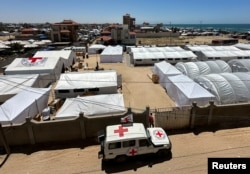Trucks began delivering aid shipments Friday through a U.S.-built temporary pier off the Gaza Strip, where, according to the U.N., famine is looming for hundreds of thousands of people and the raging war between Israel and Hamas threatens to derail humanitarian aid operations.
Vehicles ferrying humanitarian assistance began moving ashore via the pier at 9 a.m., according to U.S. Central Command.
The floating pier was preassembled by the U.S. military at the Israeli port of Ashdod and moved to the shore of Gaza this week, allowing for aid deliveries by several countries and humanitarian organizations, CENTCOM said.
No U.S. troops went ashore, it said.
Supplies will be subject to Israeli security checks in Cyprus before arriving on the pier and will have to go through additional Israeli checkpoints once they land, U.S. administration officials have said.
However, the United Nations said that truck convoys arriving by land were the “most viable, effective and efficient” method of getting aid into Gaza.
“To stave off the horrors of famine, we must use the fastest and most obvious route to reach the people of Gaza — and for that, we need access by land now,” U.N. deputy spokesperson Farhan Haq said.
Fierce battles throughout the enclave have hampered humanitarian aid deliveries, and aid groups warn that conditions are too dangerous and unstable for workers to safely deliver assistance there.
Many fear that as the Israel-Hamas war rages, the aid groups may be forced to halt operations.
“There are enormous needs” which are bound to grow, while there is “less and less access,” the head of a European charity told AFP on the condition of anonymity.
A worker for the Paris-based nongovernmental organization Humanity & Inclusion in the Palestinian territories, also speaking on the condition of anonymity, said “We can’t get our teams out; the security conditions are too unstable.”
The Rafah crossing — a key humanitarian aid corridor on the Egyptian border — has been closed since the Israeli military launched what it called a “limited” operation in Rafah city on May 7, sparking an exodus of Palestinians seeking safety farther north in Gaza.
The United Nations and other aid groups have said that Israel needs to do more to get aid into Gaza, which has been devastated by the war since Israel launched its military operation in response to the Hamas attack on Israel on October 7. Hamas has been designated a terror organization by the U.S., the U.K. and other countries.
Israel has said it is stepping up efforts to get aid into Gaza, and the military said 365 aid trucks had entered through the Kerem Shalom and Erez crossing points Thursday, carrying flour and fuel.
In addition, hundreds of tents were delivered, intended for people evacuated from Rafah to the al-Mawasi area, which Israel has declared a humanitarian zone.
“The [Israel Defense Forces] will continue its efforts to allow humanitarian aid to enter the Gaza Strip by land, air and sea, in accordance with international law,” it said in a statement.
Fierce battles in the north
Meanwhile, Israeli forces were entangled in fierce urban warfare Friday in the narrow alleys of Jabalia against reemerging Hamas cells in northern Gaza.
Israeli forces recovered the bodies of three hostages from the Gaza Strip, chief military spokesperson Daniel Hagari said Friday.
Hagari identified the hostages as Shani Louk, Amit Buskila and Itzhak Gelerenter, who he said were killed by Hamas at the Nova music festival and their bodies taken into Gaza.
Israeli armored vehicles rolled into the heart of Jabalia, the largest of Gaza’s eight historic refugee camps, and bulldozers were flattening homes and shops in the path of the advance, said residents in the area.
Rafah in the south
While fighting rages in the north, Israeli activity in Rafah has displaced hundreds of thousands of people. Since Israel’s military offensive in Rafah began, more than 630,000 people have been forced to evacuate the southern Gaza city, according to the main U.N. aid agency for Palestinians, UNRWA.
Many of them have fled to central Gaza, said UNRWA, adding that the area around the city of Deir al-Balah is now “unbearably overcrowded with dire conditions.” Deir al-Balah, up the coast from Rafah to the north, is the only other city in Gaza yet to be assailed by Israeli forces.
Israeli tanks and warplanes bombarded parts of Rafah on Friday, while the armed wings of Hamas and Islamic Jihad said they were firing anti-tank missiles and mortars at forces massing to the east, southeast and inside the Rafah border crossing with Egypt.
The October 7 Hamas attack on Israel killed 1,200 people and led to the capture of about 250 hostages, according to Israeli officials.
Israel’s subsequent counteroffensive in Gaza has killed more than 35,000 Palestinians, according to the Hamas-run Gaza Health Ministry, which includes civilians and combatants in its count but says most of the dead are women and children.
Some material in this report came from The Associated Press, Agence France-Presse and Reuters.



